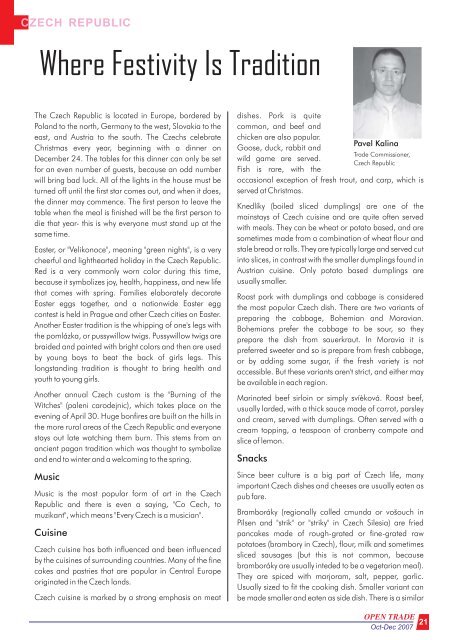pele SciaSction - new media
pele SciaSction - new media
pele SciaSction - new media
You also want an ePaper? Increase the reach of your titles
YUMPU automatically turns print PDFs into web optimized ePapers that Google loves.
CZECH REPUBLIC<br />
Where Festivity Is Tradition<br />
The Czech Republic is located in Europe, bordered by<br />
Poland to the north, Germany to the west, Slovakia to the<br />
east, and Austria to the south. The Czechs celebrate<br />
Christmas every year, beginning with a dinner on<br />
December 24. The tables for this dinner can only be set<br />
for an even number of guests, because an odd number<br />
will bring bad luck. All of the lights in the house must be<br />
turned off until the first star comes out, and when it does,<br />
the dinner may commence. The first person to leave the<br />
table when the meal is finished will be the first person to<br />
die that year- this is why everyone must stand up at the<br />
same time.<br />
Easter, or "Velikonoce", meaning "green nights", is a very<br />
cheerful and lighthearted holiday in the Czech Republic.<br />
Red is a very commonly worn color during this time,<br />
because it symbolizes joy, health, happiness, and <strong>new</strong> life<br />
that comes with spring. Families elaborately decorate<br />
Easter eggs together, and a nationwide Easter egg<br />
contest is held in Prague and other Czech cities on Easter.<br />
Another Easter tradition is the whipping of one's legs with<br />
the pomlázka, or pussywillow twigs. Pussywillow twigs are<br />
braided and painted with bright colors and then are used<br />
by young boys to beat the back of girls legs. This<br />
longstanding tradition is thought to bring health and<br />
youth to young girls.<br />
Another annual Czech custom is the "Burning of the<br />
Witches" (paleni carodejnic), which takes place on the<br />
evening of April 30. Huge bonfires are built on the hills in<br />
the more rural areas of the Czech Republic and everyone<br />
stays out late watching them burn. This stems from an<br />
ancient pagan tradition which was thought to symbolize<br />
and end to winter and a welcoming to the spring.<br />
Music<br />
Music is the most popular form of art in the Czech<br />
Republic and there is even a saying, "Co Cech, to<br />
muzikant", which means "Every Czech is a musician".<br />
Cuisine<br />
Czech cuisine has both influenced and been influenced<br />
by the cuisines of surrounding countries. Many of the fine<br />
cakes and pastries that are popular in Central Europe<br />
originated in the Czech lands.<br />
Czech cuisine is marked by a strong emphasis on meat<br />
dishes. Pork is quite<br />
common, and beef and<br />
chicken are also popular.<br />
Pavel Kalina<br />
Goose, duck, rabbit and<br />
Trade Commissioner,<br />
wild game are served.<br />
Czech Republic<br />
Fish is rare, with the<br />
occasional exception of fresh trout, and carp, which is<br />
served at Christmas.<br />
Knedlíky (boiled sliced dumplings) are one of the<br />
mainstays of Czech cuisine and are quite often served<br />
with meals. They can be wheat or potato based, and are<br />
sometimes made from a combination of wheat flour and<br />
stale bread or rolls. They are typically large and served cut<br />
into slices, in contrast with the smaller dumplings found in<br />
Austrian cuisine. Only potato based dumplings are<br />
usually smaller.<br />
Roast pork with dumplings and cabbage is considered<br />
the most popular Czech dish. There are two variants of<br />
preparing the cabbage, Bohemian and Moravian.<br />
Bohemians prefer the cabbage to be sour, so they<br />
prepare the dish from sauerkraut. In Moravia it is<br />
preferred sweeter and so is prepare from fresh cabbage,<br />
or by adding some sugar, if the fresh variety is not<br />
accessible. But these variants aren't strict, and either may<br />
be available in each region.<br />
Marinated beef sirloin or simply svíèková. Roast beef,<br />
usually larded, with a thick sauce made of carrot, parsley<br />
and cream, served with dumplings. Often served with a<br />
cream topping, a teaspoon of cranberry compote and<br />
slice of lemon.<br />
Snacks<br />
Since beer culture is a big part of Czech life, many<br />
important Czech dishes and cheeses are usually eaten as<br />
pub fare.<br />
Bramboráky (regionally called cmunda or vošouch in<br />
Pilsen and "strik" or "striky" in Czech Silesia) are fried<br />
pancakes made of rough-grated or fine-grated raw<br />
potatoes (brambory in Czech), flour, milk and sometimes<br />
sliced sausages (but this is not common, because<br />
bramboráky are usually inteded to be a vegetarian meal).<br />
They are spiced with marjoram, salt, pepper, garlic.<br />
Usually sized to fit the cooking dish. Smaller variant can<br />
be made smaller and eaten as side dish. There is a similar<br />
OPEN TRADE 21<br />
Oct-Dec 2007

















